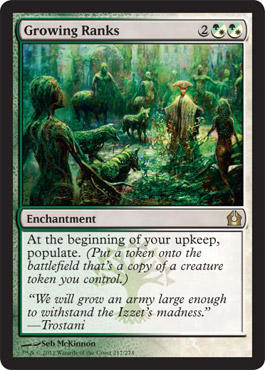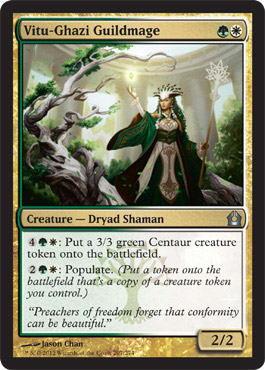The prerelease was this weekend, and there’s never been one better. The excitement (and eventual disappointment) of the Helvault was eclipsed by the guild pack concept—their best prerelease idea yet. Expounding on the faction pack idea from Mirrodin Besieged, the Return to Ravnica prerelease saw players picking one of the five Return to Ravnica guilds and being issued a special guild pack that contained a promo card specific to that guild in addition to fifteen cards guaranteed to be accessible to players who built a Sealed deck in those colors. Similar to a regular booster pack in the number of rares, commons, and uncommon, this guild pack dramatically increased the likelihood that the player could build in those colors if he or she wanted to.
And did they ever want to! Return to Ravnica not only saw a dramatic increase in the number of brand new DCI numbers registered before an event, but old players are coming out of retirement in droves. The website reddit abounded with wonderful anecdotes about the success of the Return to Ravnica prerelease concept. Anecdotes like this abound on the site, and stories of stores seeing a doubling in the number of players are common. I’m here to tell you that suddenly finding yourself cramped in what used to be a gaming area with a comfortable amount of space to spread out during the prerelease is a good thing.
A Popular Hangout
Your local game store benefits in a lot of ways by proving they can maintain a high amount of prerelease participation. Their prize support and status within the Wizards Play Network hinge on turnout to events like Friday Night Magic and prereleases, so any large uptick in attendance is going to be good for the store. But these benefits can extend far beyond just the prereleases.
Any time a new player (several of the stores where I played this weekend registered about a dozen brand new players who’d never had a DCI number before and many who had never set foot in the store) makes it to an event like this, the probability that he or she will be back increases if that player had a positive experience. This means better prize payout when the events are attendance-dependent, more trade binders, more packs opened, and so on. A new strand is added to the community’s web, and a player who has other friends who didn’t attend the Return to Ravnica event will probably be inclined to make sure he or she doesn’t miss Gatecrash. Not only that, but the odds that the player will start going to FNM and casual night are increased as well. Just like that, your LGS community grew a little bigger.
The Selsnya mechanic populate got me thinking about how exactly something like that happens. Unlike the Selesnya Conclave of years past, which used its swelled ranks to convoke big, expensive spells early by having the population all pitch in, populate is only going to help you when you already have a population to work with. It’s not going to help you build an army from scratch, but what it will do is make sure that there will be more coming when you do get started. Any brand new player who walks through the door is kind of like a Centaur or Bird token in this regard. Under the correct conditions, that player can easily be turned into two or more new players, provided he or she can convince some friends to come with next time.
In a lot of ways, Selesnya is the ideal model for the community. The work seems to be divided between spells and creatures that can produce a new token (bring a new player into the store for the first time) and those that can populate to copy an existing token (encourage the new player to come back the next week, potentially with some friends). While Azorius is concerned with strict enforcement of the rules (like the tournament organizer and judging staff), Izzet is busy with solitary pursuits such as scientific discovery, Golgari learns to make do with a shrinking player base, and Rakdos is . . . into . . . circus stuff, Selesnya is the guild with the philosophy most conducive to building a community.
Expanding the Conclave
The Vitu-Ghazi Guildmage actually has a few lessons to teach us about building a community. Since R&D did a good job of testing and balancing this card, we can presume that the mana activation costs for both of the abilities are properly weighted and in proper proportion to each other. That being the case, the mana cost on these abilities seem to make a statement about community-building; it’s 50% harder to bring in a new member from scratch than it is to get an existing member to come back and bring friends.
In our new roles as Vitu-Ghazi Guildmages, we find the harder part of our job done for us. With the lessons learned from Mirrodin Besieged’s successes and Avacyn Restored’s failures (although to be fair to AVR, the failure was really only apparent in hindsight, as the Helvault generated legitimate excitement and set the attendance records RTR just broke), Wizards of the Coast has constructed the perfect environment to maximize attendance. Forget Eyes in the Skies, the RTR prerelease was a Genesis Wave for 10. You found your store flooded with a lot of new faces, whether it’s brand new players or people who quit (everyone has a particular block to blame for their departure) and are just now coming back. The rest of our job is the easy part.
As a Vitu-Ghazi Guildmage, we don’t care whether these new additions to The Conclave were added from Grove of the Guardian or Séance. (Is this getting too nebulous? The Séance, presumably, represents players who might not come back to the store necessarily.) Every new person is a new opportunity to make people feel as though they are part of the community and that the store is the kind of place they want to hang out weekly and bring friends to. There isn’t much question that the Gatecrash prerelease will see similarly high attendance rates; half the people in the Magic community hasn’t even had a chance to play with their favorite guilds yet. But your LGS can stay as full as it was on prerelease day during the intervening months if The Conclave can find something to offer.
Casual night is an excellent way to capture the kind of player who has just played in his or her first competitive event. While Spike may not see the prerelease as particularly competitive, some newer players can find themselves daunted by something even as simple as FNM. Spending a few weeks familiarizing themselves with the store, the players, and the local metagame, that player will grow the confidence he or she needs to take on his or her first FNM. Once that hurdle is cleared, Pro Tour Qualifiers, Champs, and Grand Prix events become next; the sky is the limit. Having a night of the week when people can congregate and play Pauper, Sealed League, or Commander is an ideal way to bridge the gap between the prerelease and FNM. My best trading of the week is on casual night by far—FNM is a very distant second.
Before We Can Convoke
I have too much bulk—bulk commons and uncommons, the leavings of collections after the playables have been pulled out and sold tend to accumulate. I have limited backpack room as it is, and the prospect of taking my entire Sealed pool with me when all I want are six rares and the occasional Charm or Guildmage doesn’t appeal to me. However, picking up roughly ninety free cards really appeals to someone playing in his or her first event. I tend to use a pile of commons and uncommons from Limited events as throw-ins in trades with new players—or even as gifts. They don’t know they’re actually doing me a favor, and when they construe this gifting as generosity, what we have in that instance is pure upside. There are very few win–win scenarios in life, and helping a new player grow ninety cards closer to a collection is among my favorites. Since the store isn’t inclined to spend the evening picking up copies of Destroy the Evidence off the floors and tables, many of them have started a cards-for-kids box to help dispose of Draft chaff and donate to newer players. This isn’t all for new players, however, as I find this box is a great source of cards for Mental Magic in the event of near terminal boredom.
The Selesnya Conclave is all about nurturing. Whereas a member of the Golgari would just as soon improve him or herself by ripping the limbs from another member of his or her tribe to take home a new pair of beatin’ sticks, the Selesnya encourage growth in each of its members from the tiniest sprout to the most prohibitively expensive 15-power Wurm (someone actually resolved that against me in a Draft game last night, which had to have made his weekend). Before there are enough members of the community to convoke bigger and better events, the community must be numerous enough.
An Eye toward the Future
If Gatecrash is going to break attendance records set by Return to Ravnica, the community has to be prepared. Having adequate gaming space and enough product for everyone to play and have the guilds they want are concerns for the Azorius of the LGS. But as Vitu-Ghazi Guildmages, we have an important role as well, and that is to make sure the community is sufficiently welcoming to potential new members and that it also nurtures the growth of existing players. We have a lot of lessons to learn from the Selesnya about how to make sure our community thrives. With any luck, the next prerelease will be even better than the last.

























